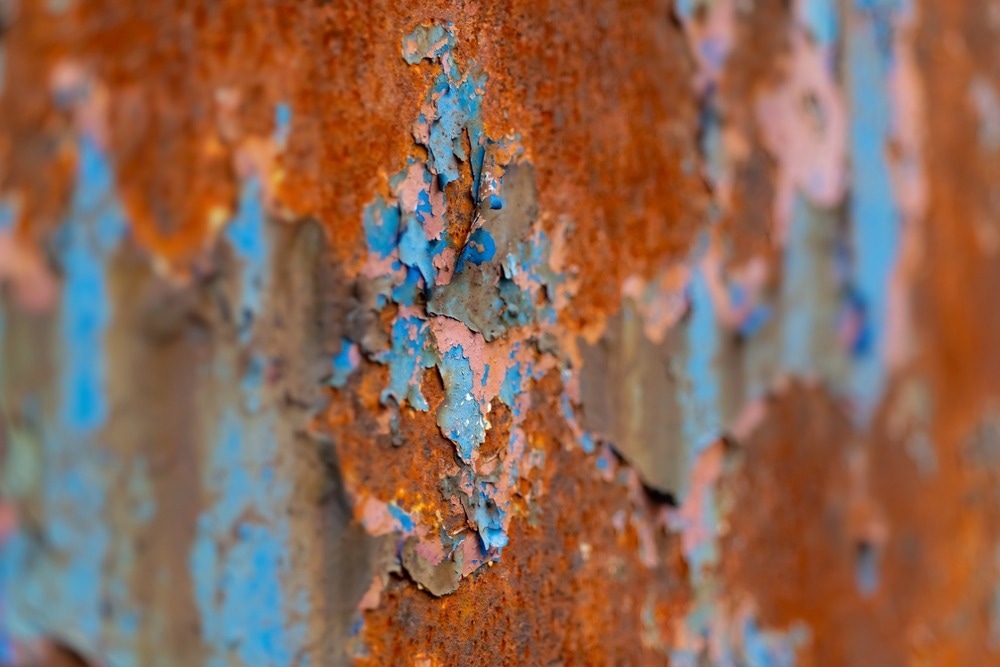A team of researchers recently published a paper in the journal Scientific Reports that evaluated the corrosion performance of steel substrates coated using superhydrophobic nanosilica and polytetrafluoroethylene (PTFE) coatings.

Study: Evaluation of corrosion performance of superhydrophobic PTFE and nanosilica coatings. Image Credit: ON-Photography Germany/Shutterstock.com
Importance of Corrosion Protection in Metals
Metal is one of the most extensively used materials in different industrial sectors, such as medical, construction, transportation, and defense. However, metal equipment and structures are prone to corrosion when they are exposed to moisture and adverse environmental conditions. Corrosion causes gradual loss of performance in metal equipment and structures and eventually leads to their destruction.
Limitations of Existing Corrosion Protection Mechanisms
Several methods based on anodic and cathodic protection, coatings, and corrosion inhibitors are utilized to prevent corrosion in metals. Among them, the coating method is commonly used to protect metal structures from chemicals, oxidation, and moisture. In this method, different substances are used to establish a barrier between the metal surface and the corrosive environment.
Coating methods, such as phosphating and chromating, are often used to protect the metal surface. However, these methods are carcinogenic and toxic to humans, and environmentally harmful. Several countries have prohibited the use of these substances to prevent the corrosion of metals.
Development of Alternative Coatings
Several studies were performed to develop coatings using alternative materials. Materials such as rare earth compound films and sol-gel-derived films have demonstrated their anti-corrosion ability. Coatings with extremely low electric conductance, such as non-conducting silica/silicon dioxide (SiO2), titanium dioxide (TiO2), and aluminum oxide (Al2O3) coatings, are also effective in corrosion protection.
Superhydrophobic Coatings
Superhydrophobic coatings with higher than 150 degrees contact angles and lower than 10 degrees roll-off angles have gained attention for anti-corrosion applications in metals. The anti-corrosion behavior of metal surfaces improves when coated with superhydrophobic coatings due to the low contact area and short contact time.
These coatings protect metals from corrosion caused by the penetration of electrolytes in the metal substrate. Superhydrophobic coatings, such as PTFE and nanosilica coatings, can be fabricated in metal and alloy surfaces, including magnesium, zinc, aluminum, and copper.
The existing methods used to fabricate PTFE coatings on metal surfaces, including chemical vapor deposition (CVD) and electrospray, typically do not create a superhydrophobic surface on metals or have several operational limitations.
For instance, the electrospray method leads to macro-molecule degradation owing to the variation in operating temperatures, while controlling the coating uniformity is difficult using the CVD method. The electrodeposition technique is considered a more suitable method for metal surface coating as it is inexpensive and can be applied on complex and large metal surfaces.
Corrosion Performance of Steel Coated with Superhydrophobic PTFE and Nanosilica Coatings
In this study, researchers used the electrodeposition and spraying process to investigate the corrosion performance of steel coated with superhydrophobic nanosilica hybrid film and PTFE coatings.
The PTFE superhydrophobic coating was fabricated by spraying on the steel surface as the method is simple with no operational limitations and can be used on all metal surfaces. The hierarchical structure in the superhydrophobic coatings was achieved using Al2O3 and glass bead microparticles and SiO2 nanoparticles as materials with extremely low electric conductance.
Researchers also prepared superhydrophobic PTFE coatings with different specifications to assess the anti-corrosion behavior of the fabricated PTFE coating. Specifically, they evaluated the effect of using two different microparticle types, including glass beads and Al2O3, in the primer layer and an overcoat layer with and without SiO2 nanoparticles on the anti-corrosion properties of the PTFE coatings.
Nanosilica superhydrophobic coatings were fabricated through the electrodeposition of inorganic/organic hybrid sol-gel films derived from tetraethoxysilane (TEOS) and dodecyltrimethoxysilane (DTMS) mixed sol-gel precursors to perform a comparative study between the anti-corrosion behavior of PTFE coatings and nanosilica coatings.
Additionally, the corrosion behavior of uncoated steel substrates was also evaluated and compared with the coated samples. Electrochemical impedance spectroscopy and TOEFL polarization tests were performed on the coated steel samples to investigate their corrosion performance in 3.5 weight percentage sodium chloride solution at 25 degrees Celsius temperature.
Significance of the Study
Nanosilica coating, PTFE coating with glass beads microparticles in the primer layer and an overcoat layer with/without SiO2 nanoparticles, and PTFE coatings with Al2O3 microparticles in the primer layer and SiO2 nanoparticles in the overcoat layer were fabricated successfully on the steel substrates.
All coated steel samples demonstrated a higher corrosion resistance than the uncoated samples. Among the coated samples, PTFE coating with glass beads microparticles displayed the highest corrosion resistance.
PTFE coating with glass bead microparticles showed a higher corrosion resistance compared to the PTFE coating with Al2O3 microparticles and silica film coating due to the lower conductivity of the Al2O3 powder and thickness of the silica film.
PTFE coating with SiO2 nanoparticles in the overcoat layer and glass bead microparticles in the primer layer displayed higher corrosion resistance than the PTFE coating with glass bead microparticles and without SiO2 nanoparticles. The SiO2 nanoparticles improved the corrosion resistance by sealing the pores and defects in the PTFE coating.
Among all coatings, PTFE coating with glass beads, microparticles and SiO2 nanoparticles displayed the most effective anti-corrosion behavior as it reduced the corrosion rate by 80 times compared to the corrosion rate of the uncoated sample.
Reference
Haji-Savameri, M. et al. (2022). Evaluation of corrosion performance of superhydrophobic PTFE and nanosilica coatings. Scientific Reports. https://www.nature.com/articles/s41598-022-20729-z
Disclaimer: The views expressed here are those of the author expressed in their private capacity and do not necessarily represent the views of AZoM.com Limited T/A AZoNetwork the owner and operator of this website. This disclaimer forms part of the Terms and conditions of use of this website.